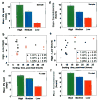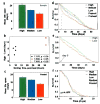A stress-sensitive reporter predicts longevity in isogenic populations of Caenorhabditis elegans
- PMID: 16041374
- PMCID: PMC1479894
- DOI: 10.1038/ng1608
A stress-sensitive reporter predicts longevity in isogenic populations of Caenorhabditis elegans
Abstract
When both genotype and environment are held constant, 'chance' variation in the lifespan of individuals in a population is still quite large. Using isogenic populations of the nematode Caenorhabditis elegans, we show that, on the first day of adult life, chance variation in the level of induction of a green fluorescent protein (GFP) reporter coupled to a promoter from the gene hsp-16.2 predicts as much as a fourfold variation in subsequent survival. The same reporter is also a predictor of ability to withstand a subsequent lethal thermal stress. The level of induction of GFP is not heritable, and GFP expression levels in other reporter constructs are not associated with differences in longevity. HSP-16.2 itself is probably not responsible for the observed differences in survival but instead probably reflects a hidden, heterogeneous, but now quantifiable, physiological state that dictates the ability of an organism to deal with the rigors of living.
Figures



References
-
- Finch, C.E., & Kirkwood, T.B. Chance, Development and Aging, (Oxford University Press, London, 2000).
-
- Kirkwood TB, Finch CE. Ageing: the old worm turns more slowly. Nature. 2002;419:794–5. - PubMed
-
- Finch CE, Tanzi RE. Genetics of Aging. Science. 1997;278:407–411. - PubMed
-
- Johnson TE. Increased life-span of age-1 mutants in Caenorhabditis elegans and lower Gompertz rate of aging. Science. 1990;249:908–12. - PubMed
-
- Johnson TE, et al. Gerontogenes mediate health and longevity in nematodes through increasing resistance to environmental toxins and stressors. Exp Gerontol. 2000;35:687–94. - PubMed
Publication types
MeSH terms
Substances
Grants and funding
LinkOut - more resources
Full Text Sources
Other Literature Sources

